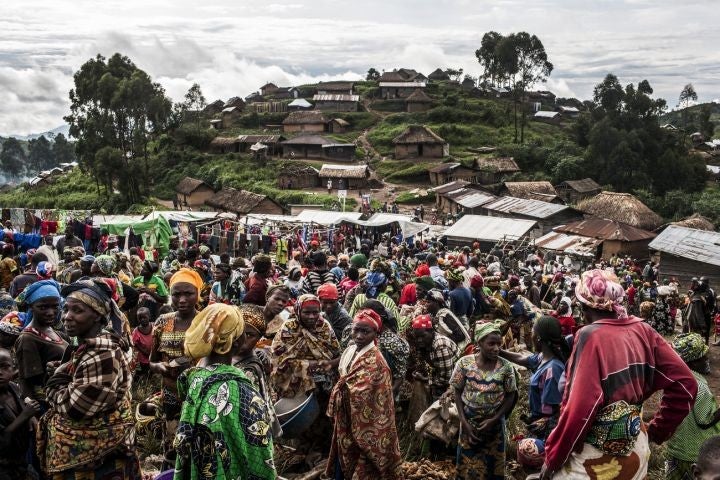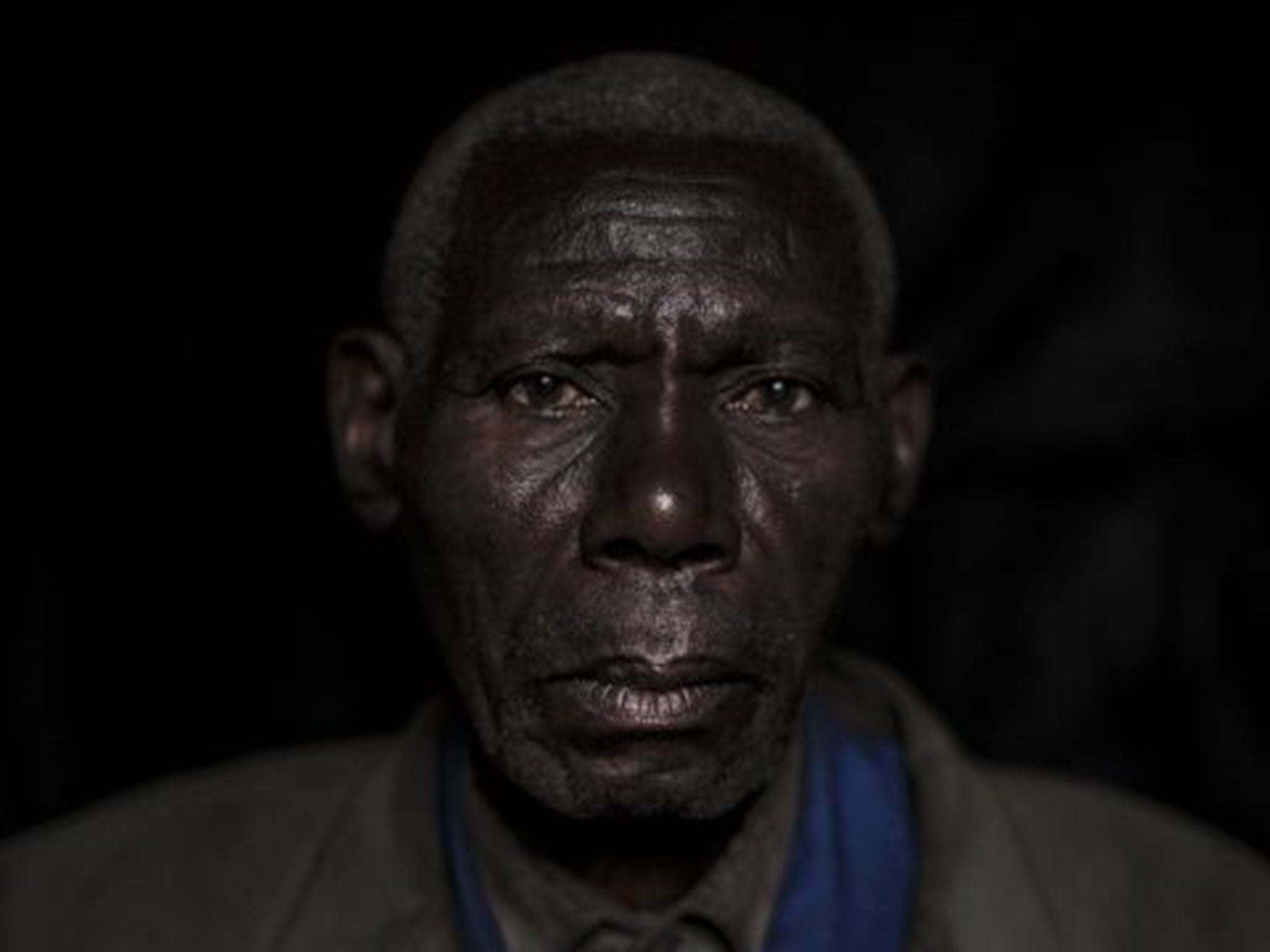A day of peace for a village at the centre of Congo's bloody war - but the militias could return at any time
The experience of Kivuye epitomises the violence and misery of one of Africa’s longest-running conflicts, with its inhabitants living in a state of constant fear

Your support helps us to tell the story
This election is still a dead heat, according to most polls. In a fight with such wafer-thin margins, we need reporters on the ground talking to the people Trump and Harris are courting. Your support allows us to keep sending journalists to the story.
The Independent is trusted by 27 million Americans from across the entire political spectrum every month. Unlike many other quality news outlets, we choose not to lock you out of our reporting and analysis with paywalls. But quality journalism must still be paid for.
Help us keep bring these critical stories to light. Your support makes all the difference.
On the first market day after the militia retreated, as the midday sun broke through the mist, hundreds of villagers gathered on a grassy hillside. Vendors sold fresh cabbage, corn and potatoes without fear of being robbed. Women bought dresses without fear of being raped. Children kicked a tattered ball without fear of being dragged away and forced to carry a gun.
But Bernard Kamanzi was nervous. As the top government official, he knew such freedom always vanished quickly. The Congolese soldiers who had been fighting the militias and protecting the village had withdrawn that morning. “The militias could come back at any moment,” he said. “That’s the fear we have.”
The village of Kivuye in eastern Congo lies at the centre of one of Africa’s most brutal and longest-running wars. It is both military base and refugee camp, both killing field and sanctuary. Civilians trapped in relentless violence struggle to live. Death arrives in many forms – guns, machetes, disease and hunger.
It is a war that has claimed five million lives, many from starvation, disease and other conflict-related causes, since 1998. It is a war that the world’s largest and most expensive UN peacekeeping mission has failed to quell.
Yet the war remains invisible to most outsiders, who have grown weary of the unending cycle of violence. Today relief groups have trouble raising money to help Congo as more publicised upheavals in Syria, South Sudan and elsewhere grab the world’s attention.
The story of Kivuye over a few months this year offers a glimpse into why the conflict seems so complex, and the solutions to Congo’s misery so elusive. Even during brief periods of calm, residents still grapple with the forces the war has wrought.
When the market reopened in Kivuye, the most liberating day in years, villagers did not know that the militia had retreated only to the forest, waiting to return. In a few days another warlord who once ruled the village would come back. In a few weeks, Congolese army soldiers sent to protect them would commit mass rapes nearby.
Sprawled across an emerald hilltop, Kivuye is an expanse of mud huts, plywood shacks and tiny shops connected by rugged paths. There is no electricity, running water or phone reception. A craggy road that snakes through the village’s centre has carried armies of every stripe, from jaded peacekeepers to renegade soldiers to fighters who believe that bullets bounce off their bodies.
If anyone knows the arc of Kivuye’s destruction, it’s Azarias Mataboro. The 73-year-old former tribal chief remembers when Belgian colonialists operated tea plantations. And though the Belgians brutally lorded over Congo, he remembers them as more benevolent than the rulers who followed: an American-backed, corrupt dictator who changed the country’s name to Zaire and favoured leopard-skin hats and champagne; his equally venal successor, who wore Mao-style suits; and his son, who now presides over Congo.

Mr Mataboro remembers the roots of Kivuye’s tragedy. The Rwandan genocide in 1994, when ethnic Hutu extremists slaughtered 800,000 ethnic Tutsis and their Hutu sympathisers, gave birth to Congo’s mayhem. As the violence ended in Rwanda, a million or more Hutus fearing reprisals fled across the border into Congo, triggering a succession of conflicts.
Congo’s vast mineral deposits were plundered by all sides. Twenty years later, the genocide’s legacy reverberates even as Rwanda enjoys peace and prospers. Congo’s armed groups remain engaged in a murky contest over power, wealth and identity, and tensions between Hutus and Tutsis still play out.
“We are still feeling the impact of the Rwandan genocide,” said Faustin Mbara, a priest in the town of Kitchanga, along the route to Kivuye, whose Catholic parish oversees scores of villages in the region. “The spirit of vengeance spread, and it continues today in the Congo.” Colonel Bigirabagabo seized control of Kivuye in December. A Hutu in his mid-to-late thirties, Bigirabagabo was a former government soldier who defected to launch his own militia. Innocent Bauma, a 15-year-old former fighter, said he witnessed the warlord kill five of his own men for disobeying orders. “He shot them,” said Bauma, who ran away after the incident and surrendered to the Congolese army.
For more than a year, Bigirabagabo’s fighters plundered hamlets in the region. But when the warlord who had been ruling Kivuye agreed to join a government disarmament programme, Bigirabagabo and his fighters took over. No one challenged the militia. The village police force had only six members and one rifle. Like his predecessor, Bigirabagabo ordered every resident to pay a “right to life” tax of roughly £1 each month.
Everyone was considered a target. The gunmen stopped Kanyeshamba Gwagitare days after he arrived in Kivuye in January and struck him 20 times with a thick cane for failing to pay the tax.
“You flee, thinking you are going to your brother, thinking he will protect you,” said Gwagitare, who arrived with his pregnant wife and five children after escaping another militia. “But instead of protecting you, he beats you. What can you do? He has a gun. You keep quiet.”
Ignoring long-held tribal hierarchy, the fighters undermined the village elders. They also chipped away at Bernard Kamanzi’s authority. Mr Kamanzi, 42, the top government official in Kivuye, said: “Colonel Bigirabagabo was acting as the chief of post, the chief of police and the chief of the village.”
The villagers stopped going to Mr Kamanzi for advice and help. Some turned to the village’s new rulers to resolve disputes. “It was humiliating,” Mr Kamanzi said. “But I was buying time to save my life.”
In March, the warlord and his 50 men retreated from the village when a government army regiment arrived. It brought a sense of hope, evident on that first market day after the militia left.
But after the soldiers left, Bigirabagabo and his fighters were lurking in the forests. Worse, the warlord who ruled Kivuye before them had returned to the area and was living just five miles away. “The fear is that he may regroup his fighters and restart his rebellion again,” said Mr Kamanzi.
© Washington Post
Subscribe to Independent Premium to bookmark this article
Want to bookmark your favourite articles and stories to read or reference later? Start your Independent Premium subscription today.
Join our commenting forum
Join thought-provoking conversations, follow other Independent readers and see their replies
Comments